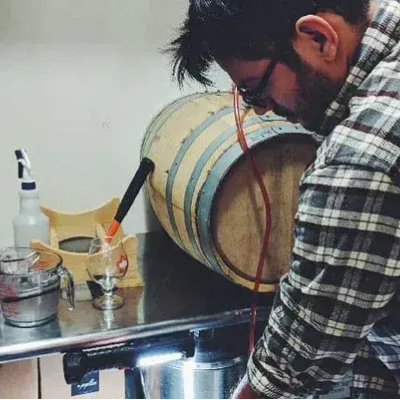Guide: whiskey Barrel-Aging with New 5 Gallon Oak Barrels
February 24th, 2023

Barrel-aging doesn’t have to be a black box. However, for many, especially homebrewers and home winemakers, buying that first small barrel is daunting.
We understand why – and we’re here to make it easier.
One of the top questions asked by those ready to dip their toes into barrel aging is: What’s the best barrel for beginners?
Our first answer is often – it depends. The best barrel for your beer, wine or whatever you make at home depends on what flavors and aromas you want. For some, a used small barrel that held bourbon or whiskey might be the answer.
Whether you go new or used, at the end of the day, all you need is a good barrel.
That’s where Midwest Barrel Co. can help.
NEW OR USED 5-GALLON BARRELS?
However, many customers interested in small format barrels go with brand-new, never-used five-gallon barrels. Why? Think of it as a blank canvas. By starting from scratch with new oak, you get more influence over the end product.
Don’t worry, though! We’re not going to leave you hanging with that. We’ve got all you need to know about new five-gallon barrels right here.
WHY START WITH A NEW 5-GALLON OAK BARREL

A new five-gallon barrel that’s never been used before is one of the best options for starting out simply because you can better control what flavors and aromas will be added to whatever you age inside it.
For example, many of our homebrewing customers have a favorite bourbon or whiskey with specific notes they want to add to a barrel-aged homebrew. It’d be nearly impossible for nearly all homebrewers to be able to brew 53-plus gallons of beer quickly enough to fill a full-size used bourbon or whiskey barrel.
That’s probably just not happening.
However, it’s much easier to grab a bottle of your favorite bourbon, empty it into a 5-gallon barrel and let it soak for a while. (Don’t worry, we will cover how to do this in a bit.)
THE ALTERNATIVE: USED, 5-GALLON BOURBON OR WHISKEY BARRELS

Before we dive into the process of aging your homebrewed beer or homemade wine – or other beverage – in a new barrel, let’s quickly go over the alternative.
Used small formats – typically five gallons or 10+ gallons if your system can swing it – are the in-between for homebrewers who want a barrel that’s been filled by an experienced craft distillery to age bourbon or whiskey. These barrels typically aged the spirit for several months to, at most, about two years. The barrels were also full, as opposed to pouring a bottle of bourbon into a new barrel. Both methods work for aging your brew, of course. It just comes down to your preference.
If you want a freshly emptied barrel from an actual distillery, then a used small format barrel is the best option.
WHAT TO KNOW ABOUT NEW 5-GALLON OAK BARRELS
However, as we’ve said, many customers prefer new barrels that have never been filled. Should you choose to go the new barrel route, then there are quick few things you need to know.
Source: Midwest Barrel Company sources its new five-gallon barrels from an independent, family-owned and operated cooperage.
Wood: Like full-size whiskey and bourbon barrels, these are made from American white oak.
Char level: Our new, never used 5-gallon barrels are charred at the cooperage to a medium level. Learn more about how charring influences barrels.
Faster aging: Unlike full-size barrels, you won’t need to age any spirit, wine or beer in these for years. Instead, anywhere from a few weeks to a few months may be enough. That’s because, the smaller the barrel, the higher the ratio of liquid that comes into contact with the oak. Sample often.
Bunghole size: The bunghole is 1 5/16 inches. We include a 1 5/16-inch wooden bung with all new five-gallon purchases, or customers can purchase a reusable silicone #8 bung.
HOW TO BARREL-AGE WITH A NEW 5-GALLON BARREL

Whether you go with a new or used barrel, the aging process is, for the most part, largely the same.
However, if you’ve pulled the trigger on new, then there are a few additional steps that must be taken to prep the barrel before filling with your beer, wine or other beverage.
1. Brew the beer or other beverage
Barrels are a big deal. For distilleries and wineries, the oak is what influences and imparts specific flavors and aromas. Master distillers will tell you that whiskey gets up to 70% of its flavor from the barrel.
That's why distilleries obsess over everything about where a barrel originated, from where the trees were harvested, to how long the wood seasons outside, to the many different toast and char levels.
The specifics of a barrel matter for craft breweries and even homebrewers, too, although it's more from the perspective of how a barrel will influence the already established flavors of the beer.
So, do your research on what type of beverage you want to make. This is the first and most important step to barrel-aging.
Need a suggestion? Why not start with our homebrew barrel-aged imperial stout recipe?
2. Swell and prep the barrel
Onto the barrel! There is always a little more prep work required whenever you want to age in a new barrel.
First, you need to swell the barrel. Swelling the barrel allows the oak staves to absorb water, swell and tighten up to prevent leaks.
To swell your barrel:
1. First rinse with water three or four times to work up and remove any charred wood or flakes.
2. Fill the barrel with hot water (at least 180 degrees F) and place a 1 5/16 bung in the bunghole.
3. Take a close look around the entire barrel, noting any leaks. Top off the barrel with hot water until all leaking stops. This could take a few hours or it could take up to a week. Every barrel is different.
4. Empty the barrel once the leaking has stopped.
The barrel is now ready to fill.
3. Fill the barrel
With no more leaks, it’s time to fill. If you aren’t sure what equipment you will need for this step, then we recommend reading either this article from Brew Your Own or this post from Secret Level Brewing.
4. Age and sample
Most small barrels will age contents relatively quickly compared to larger barrels. For 5 gallons, we are likely looking at several weeks for some brews to several months for others.
You’ll know your brew is ready to exit the barrel when it meets your desired flavor. The only way to know when that is, is to take samples using a Vinnie nail.
With a Vinnie nail, pair of pliers and a small glass or cup at the ready, you can quickly take a small sample, return the nail and taste.
Here is how to install and use a Vinnie nail.
5. Empty, bottle and repeat
Once the beer tastes up to your standards or preferred flavors, it’s time to get it out of the barrel. Again, see the Brew Your Own or Secret Level Brewing posts for more information and helpful pointers on transferring to bottles.
6. Keep your barrel clean
You’re not done with your barrel yet! In fact, if you are able to seal it up with a clean wooden bung, or better yet a resealable silicone bung, then it should still be refillable within about a week.
The best way to keep the barrel sanitary is to refill it immediately after emptying. So, while you’re tasting and sampling, consider when it might be appropriate to get a new batch started.
If the barrel does have to sit empty for a longer amount of time, then we recommend keeping the bung in place, wrapping it with an air tight plastic wrap and storing in a dark, cool, even slightly damp place.
More Homebrewer Resources
Good luck aging with your barrel! Let us know how your beer, cider, mead, wine or spirit turns out.
If you are a homebrewer, home winemaker or make other beverages at home, then be sure to check out our Homebrewing Blog for even more barrel-aging and barrel care resources for small format barrels.

ABOUT THE AUTHOR:
Ethan Schulenberg
If you’re a brewer, you’ve probably spent time chatting with Ethan. More than just a sales guy, he genuinely cares about our customers and takes pride in helping them be successful in whatever barrel project they’re embarking on.





